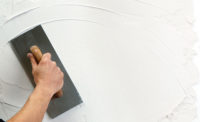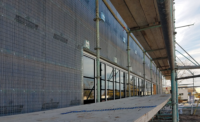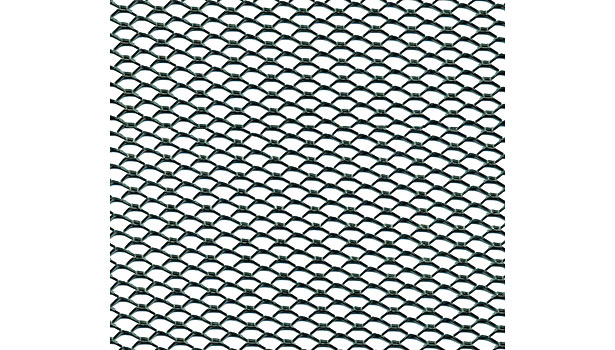Metal Lath Products
Best Practices for Selection, Installation of Expanded Metal Lath Products








Expanded diamond-mesh metal lath products have long been a key component of stucco-clad building exteriors, which consist of plaster applied over wood or gypsum sheathing. Though expanded metal lath may appear to be a rather basic, uncomplicated building material, the expanded metal lath product specified, and the way it is installed, has a huge impact on the long-term stability of the plaster it supports. Since not all metal lath products are created equally in terms of quality, it is crucial to research the performance attributes of each product being considered before making a final decision.
Fortunately, there are several building codes and industry standards available today to steer specifiers toward a high-performance expanded metal lath product and installers toward proper installation steps. In this article, we will cover industry guidelines for selecting metal lath products that meet the requirements of current international building codes. In addition, we will share common metal lath installation errors and counter them with the proper installation techniques. Adherence to the guidelines in each of these disciplines can help building and design professionals produce stable, long-lasting exterior wall assemblies.
Specifying Quality Products
Before specifying an expanded metal lath product, it is important to verify that it has first passed testing conducted by an independent third party for compliance with the International Building Code, the International Residential Code and the industry standards they reference. The industry standards most widely used by the IBC and IRC to gauge the product performance needed for code compliance are ASTM C847, Standard Specification for Metal Lath, and ASTM C1063, Standard Specification for Installation of Lathing and Furring to Receive Interior and Exterior Portland Cement-Based Plaster.
Building Code Requirements
The IBC and IRC call upon ASTM C847 to define the expanded metal lath’s physical properties required for code compliance. This standard lists minimum lengths, widths, lath thicknesses and weights for products, as well as allowable tolerances. In order to meet these criteria, metal lath manufacturers have to pay close attention to a variety of details in their product design, including: the base thickness of the galvanized steel coil, cutter configurations and the pull force applied to the galvanized steel coil while being stretched.
ASTM C847 calls for metal lath to be manufactured from cold-rolled carbon steel sheets, per ASTM A653, Standard Specification for Steel Sheet, Zinc-Coated (Galvanized) or Zinc-Iron Alloy-Coated (Galvannealed) by the Hot-Dip Process. In addition, ASTM A653 requires hot-dipped galvanized lath to have a coating of at least G-60, signifying a zinc content of 0.6 ounces per square feet (183 grams per square meter).
While the minimum galvanized coating required by ASTM C847 is G-60, it is possible to use other materials to protect metal lath from corrosion, such as increasing the galvanization to G-90, where zinc content increases to 0.9 ounces per square feet (274 grams per square meter) in protective coating or pure zinc alloy (99 percent pure zinc).
Expanded Metal Lath Accessories
The lath accessories selected for a particular project depends largely on the regional climate of the construction site, along with the type of plaster/stucco or stone application used to form the façade. For instance, the high humidity and salty air of coastal environments often demands zinc alloy or PVC exterior skin components. In drier climates, however, galvanized accessories are acceptable. It should be noted that there may be trade-offs with certain materials.
For example, while zinc alloy offers greater corrosion resistance, the material is considerably softer than galvanized steel. And, while PVC accessories allow no oxidation, they may not fit the building owner’s aesthetic preferences.
Another important thing to remember is that grouping incompatible materials in the final specification of lath, fasteners and accessories can increase the possibility of galvanic corrosion (i.e. electrolysis) or inconsistent corrosion protection, which threatens the long-term stability of the building’s cladding.
Proper Installation Is Key
Proper lath installation is of equal importance to the stability of plaster-based building exteriors. Below are some of the most common lath-related installation errors and how they can be avoided:
Improper Plywood Sheathing Installation: According to the American Plywood Association, plywood sheathing should be installed with a minimal gap of 1/8-inch between sheets to accommodate any expansion that may occur in the wood as a result of moisture intrusion. It is important to note that in cases where large amounts of moisture enter the exterior wall assembly; the plywood may delaminate or swell significantly, ultimately causing the stucco cladding to deteriorate. The best protection against these liabilities is an effective moisture management strategy within the exterior wall assembly, consisting of high-performance insulation, air barriers and vapor retarders or barriers.
Improper Installation of Water-resistive Barriers: Chapter 25 of the IBC states that exterior wall assemblies shall include two independent layers equivalent to Grade D paper that serve as water-resistive barriers. The only exception is the use of 60-minute Grade paper and a non-water-absorbing layer drainage plane, or rainscreen.
Improper Metal Lath Installation: Some of the more severe metal lath installation errors involve improper lapping attachment to the framing members, improper installation of paper-backed metal lath, incorrect fastening of the adjoining sheets at the laps and the improper orientation of the lath sheets. A well-defined installation primer for metal laths (with or without paper backings) can be found in ASTM C1063, or the Expanded Metal Lath Association’s Guide Specifications for Metal Lathing and Furring (EMLA 920-09) and can guide the contractor toward a successful installation.
Improper Fastening of Metal Lath: Improper fastening of expanded metal lath is the most common installation error and is often a result of the lath being randomly stapled or nailed to the sheathing instead of the structural member. ASTM C1063 requires lath fastening at minimal intervals of 7 inches on center. Lath accessories’ flanges must directly touch the lath, with no weather barrier sandwiched in-between.
Improper Installation of, or an Inadequate Number of, Expansion & Control Joints: ASTM C1063 defines control joints as one-piece joints used to provide crack control for stucco shrinkage, drying and thermal expansion. The same standard describes expansion joints as two-piece joints used to accommodate some degree of movement in the stucco membrane caused by movement in the building or its components. Fastening the expansion joint flanges to sheathing, or leaving the lath un-cut behind the joint, negates the lath’s effectiveness.
Just like all accessories, the expansion joints must be wire-tied to lath edges or, in some applications, attached to supports at spacing that ensures stability. On large, vertical surfaces, it is wise to make vertical joints continuous and cut horizontal joints to abut the verticals, with proper care taken to prevent the horizontal joints from impeding the vertical joints’ movement.
Improper Installation of Flashing or Sealants: Poorly installed or omitted flashing in areas where water can enter the exterior wall assembly can easily cause the cladding, sheathing and wood framing members to deteriorate. Mold growth may also result from extended moisture exposure, causing indoor air quality problems inside the building. Though flashing is generally not the responsibility of the lath contractor, notifying the general contractor of any improperly installed flashing or areas where flashing was left uninstalled can save the project team some trouble in the long run.
Conclusion
In order to provide customers with high-performance, long-lasting building exteriors and minimize liabilities, it is imperative for building and design professionals to keep themselves up-to-date on all applicable building codes and ASTM standards. Adherence to the guidelines covered above will produce healthier, more stable and sustainable buildings and reduce callbacks.
Looking for a reprint of this article?
From high-res PDFs to custom plaques, order your copy today!










